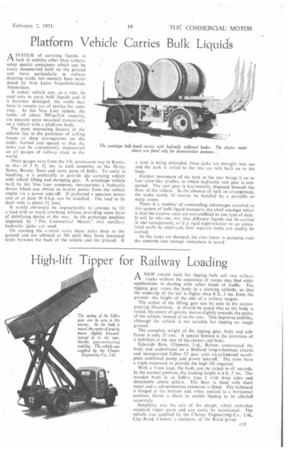Platform Vehicle Carries Bulk Liquid's
Page 51

If you've noticed an error in this article please click here to report it so we can fix it.
ASYSTEM of carrying liquids in bulk in vehicles other than tankers, using special containers which can be easily .nianceuvred both on the ground and more particularly in railway shunting yards, has recently been introduced by Van Leers Vatenfabrieken, Amsterdam.
A tanker vehicle can, as a rule, be used only to carry bulk liquids and. if it becomes damaged, the outfit may have to remain out of service for some
time. In the Van. Leer system, the tanks, of about 700-gallon capacity, are separate units mounted transversely on a vehicle with a platform body.
The most interesting feature of the scheme lies in the provision of rolling hoops or deep Corrugations on the tanks, formed and spaced so that the tanks can he conveniently mamtuvred on all gauges of railway track in the world.
These gauges Vary from the 5-ft. permanent way in Russia, to that of 3 ft. 3/ ins, in such countries as the Malay States, Burma. Siam and some parts of India. To assist in handling, it is preferable to provide ttie carrying vehicle with inbuilt lifting and dumping gear. A prototype vehicle built by the Van Leer company, incorporates a hydraulic device which can obtain its motive power from the vehicle engine via a power take-oft. If preferred a separate power unit of at least 10 b.h.p. can be installed. The load to be dealt with is about XI tons.
It would obviously be impracticable to attempt to lift a load with so much overhang without providing some form of stabilizing device at the rear. In the prototype machine inSpected by The Commercial -Motor," two auxiliary hydraulic jacks are used.
On opening the centrol valve these jacks drop to the ground and are allowed to lift until they form tensioned struts between the back of the vehicle and the ground, If
a tank is being unloaded, thesejacks are brought into use and the tank is rolled to the rear on rails built on to the body.
Further movement of the tank to the rear brings it on to four claw-like cradles, to which hydraulic ram gear is connected. The ram gear is horizontally disposed beneath the floor of the vehicle. In the absence of such an arrangement. the tanks could, of course, be handled by a portable or static crane.
There is a number of outstanding advantages attached to this system of bulk-liquid transport, the chief amongst which is that the tractive units are not confined to one type of duty. It will be obv■ous, too, that different liquids can be carried in one consignment, as if a rigid eight-wheeler or an articulated outfit be employed, four, separate tanks can readily be carried.
As the tanks are dumped, the lime taken in pumping over the contents into storage containers is saved.




























































































